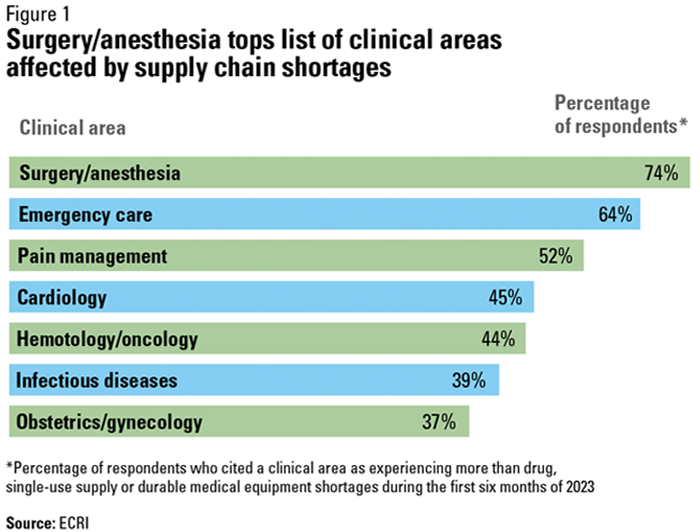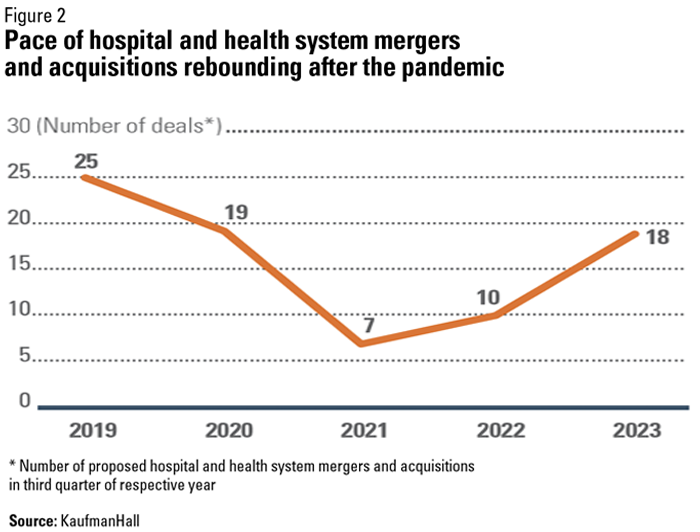
Health Care Supply Chain Strategies
Streamlining Supply Chain Practices as Health Systems Expand
Supply chain challenges facing hospitals, health systems and medical practices didn’t end when the COVID-19 Public Health Emergency expired on May 11, 2023. The depth of the nationwide shortage of personal protective equipment has been replaced by the breadth of nationwide shortages of everything from prescription drugs to fetal scalp electrodes, sterile water and syringes.
At the same time, many hospitals, health systems and medical practices are still recovering from the negative financial impact caused by the pandemic — reduced revenue largely due to declining patient volume and higher expenses primarily caused by higher labor costs and inflation. That has prompted many provider organizations to consider and execute strategically driven mergers, acquisitions and openings or expansions of care sites or services.
This report details how health care supply chain leaders deploy people, processes and technology to manage these dynamics across the country. Done well, supply chain leaders can convert what could be a logistical nightmare into a significant opportunity to create value for their organizations, communities and patients.
Two Key Challenges
Two macroeconomic trends — more supply chain challenges and more M&A activity — meet at the door to the supply chain director’s office. It’s the supply chain leader’s job to simultaneously juggle and manage both, as adding a new hospital, medical practice, site or service only serves to multiply whatever supply chain issues exist.



3 Areas of Concentration
To excel in responding to these challenges, supply chain leaders need to concentrate on three areas: people, processes and technology. Getting the right people starts by assessing existing staff resources and knowing what additional resources may be needed.
Job 1 for improving processes becomes eliminating duplicate processes and reducing product variation. That starts with the item master formulary. It’s the master list of all the products — drugs, supplies and equipment — approved for use and contracted for. The two parties essentially must reconcile their item masters and merge them into one.
Similar to processes starting with reconciling item masters, technology starts with reconciling ERP systems. With the right planning and execution in three domains — people, processes and technology — hospitals and health systems can rein in those metrics and point all the needles in the right direction.

Case Study: Munson Healthcare
Munson Healthcare, a primarily rural health system in Traverse City, Michigan, now includes 1,000 physicians in 63 medical specialties. With each merger, Munson adjusts its supply chain operations. Today, that responsibility falls to Tracy Cleveland, Munson’s vice president of supply chain, a position he’s held since September 2020. Cleveland says four supply chain issues immediately bubble to the surface the minute he learns about a proposed Munson merger, acquisition or expansion. In ranked order of concern are:
- Staffing.
- Product availability.
- Proximity.
- Technology.

Case Study: BJC HealthCare
Tom Harvieux, vice president and chief supply chain officer at BJC HealthCare, can’t be clearer. The success of a supply chain integration after the St. Louis-based health system completes a merger or acquisition, opens a new care site, or launches or expands a new clinical service is standardization. That applies to everything from raw data to contract terms. Without it, BJC can’t realize the full clinical, financial and operational value from any type of expansion of its patient care footprint.
Harvieux is quick to name his three biggest daily supply chain challenges when he logs on to his supply chain management system:
- Data quality.
- Lack of visibility with “trading partners” (i.e., vendors, suppliers, manufacturers, distributors and group purchasing organizations).
- Product variation.
Download Now
Streamlining Supply Chain Practices as Health Systems Expand





